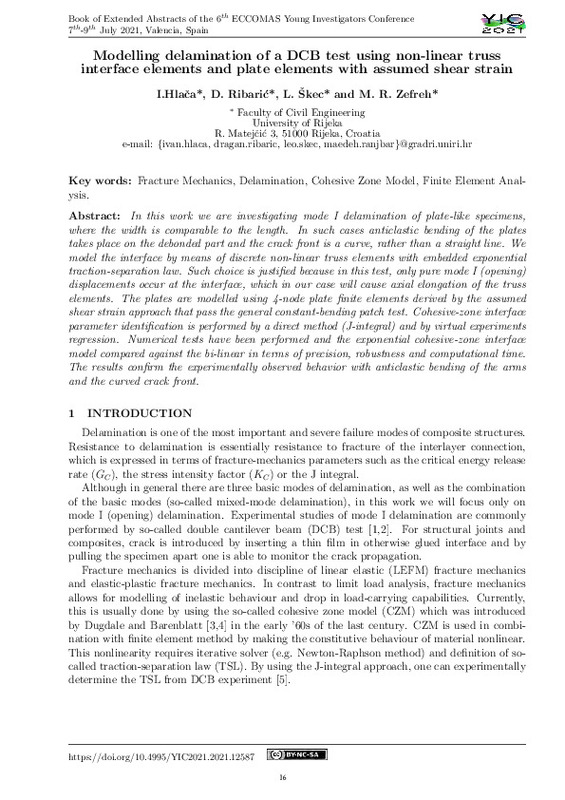JavaScript is disabled for your browser. Some features of this site may not work without it.
Buscar en RiuNet
Listar
Mi cuenta
Estadísticas
Ayuda RiuNet
Admin. UPV
Modelling delamination of a DCB test by using non-linear truss interface elements and plate elements with assumed shear strain
Mostrar el registro sencillo del ítem
Ficheros en el ítem
| dc.contributor.author | Hlača, Ivan
|
es_ES |
| dc.contributor.author | Ribarić, Dragan
|
es_ES |
| dc.contributor.author | Škec, Leo
|
es_ES |
| dc.contributor.author | Zefreh, Maedeh
|
es_ES |
| dc.date.accessioned | 2022-09-28T06:31:04Z | |
| dc.date.available | 2022-09-28T06:31:04Z | |
| dc.date.issued | 2022-05-11 | |
| dc.identifier.isbn | 9788490489697 | |
| dc.identifier.uri | http://hdl.handle.net/10251/186643 | |
| dc.description.abstract | [EN] Fracture resistance of structural adhesive joints is key for their application in the industry. Mode-I adhesive joint delamination is the most severe type of fracture and the possibility of this outcome should be avoided whenever possible. In this work we are investigating mode-I delamination of plate-like specimens, where the width is comparable to the length. In such cases anticlastic bending of the plates takes place on the debonded part and the crack front is a curve rather than a straight line. We model the interface by means of discrete non-linear truss elements with embedded exponential traction-separation law [1]. Such choice is justified because in this test, only pure mode-I (opening) displacements occur at the interface, which in our case will cause axial elongation of the truss elements. The plates are modelled using 4-node plate finite elements derived by the assumed shear strain approach that pass the general constant-bending patch test [2]. Cohesive-zone interface parameter identification is performed by a direct method (J-integral) [3] and by virtual experiments regression. Numerical tests have been performed and the exponential cohesive-zone interface model compared against the bi-linear in terms of precision, robustness and computing time. The results confirm the experimentally observed behaviour with anticlastic bending of the arms and the curved crack front. | es_ES |
| dc.format.extent | 8 | es_ES |
| dc.language | Inglés | es_ES |
| dc.publisher | Editorial Universitat Politècnica de València | es_ES |
| dc.relation.ispartof | Proceedings of the YIC 2021 - VI ECCOMAS Young Investigators Conference | |
| dc.rights | Reconocimiento - No comercial - Compartir igual (by-nc-sa) | es_ES |
| dc.subject | Fracture mechanics | es_ES |
| dc.subject | Delamination | es_ES |
| dc.subject | Cohesive zone model | es_ES |
| dc.subject | Finite element analysis | es_ES |
| dc.title | Modelling delamination of a DCB test by using non-linear truss interface elements and plate elements with assumed shear strain | es_ES |
| dc.type | Capítulo de libro | es_ES |
| dc.type | Comunicación en congreso | es_ES |
| dc.identifier.doi | 10.4995/YIC2021.2021.12587 | |
| dc.rights.accessRights | Abierto | es_ES |
| dc.description.bibliographicCitation | Hlača, I.; Ribarić, D.; Škec, L.; Zefreh, M. (2022). Modelling delamination of a DCB test by using non-linear truss interface elements and plate elements with assumed shear strain. En Proceedings of the YIC 2021 - VI ECCOMAS Young Investigators Conference. Editorial Universitat Politècnica de València. 16-23. https://doi.org/10.4995/YIC2021.2021.12587 | es_ES |
| dc.description.accrualMethod | OCS | es_ES |
| dc.relation.conferencename | VI ECCOMAS Young Investigators Conference | es_ES |
| dc.relation.conferencedate | Julio 07-09, 2021 | es_ES |
| dc.relation.conferenceplace | Valencia, España | es_ES |
| dc.relation.publisherversion | http://ocs.editorial.upv.es/index.php/YIC/YIC2021/paper/view/12587 | es_ES |
| dc.description.upvformatpinicio | 16 | es_ES |
| dc.description.upvformatpfin | 23 | es_ES |
| dc.type.version | info:eu-repo/semantics/publishedVersion | es_ES |
| dc.relation.pasarela | OCS\12587 | es_ES |
| dc.contributor.funder | Croatian Science Foundation | es_ES |








